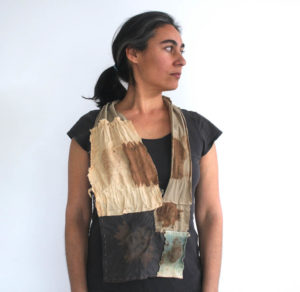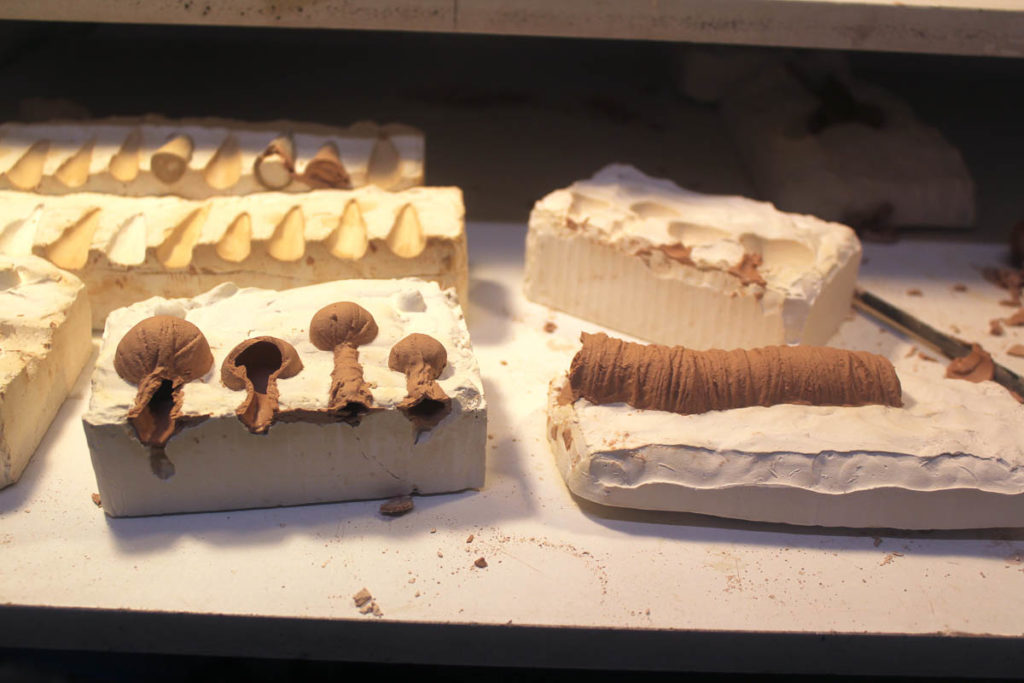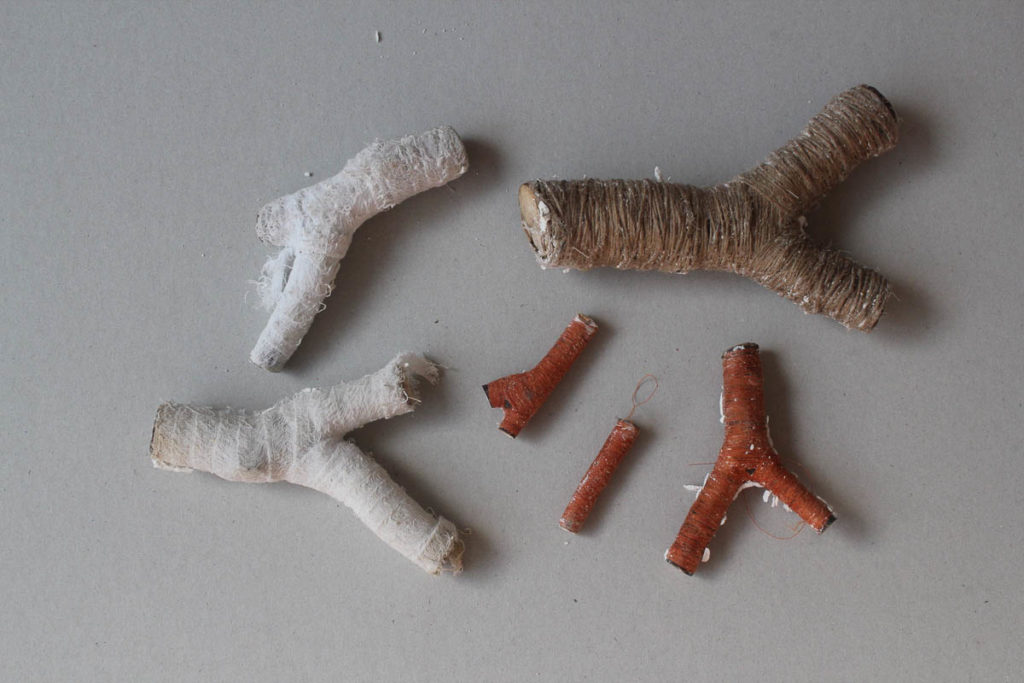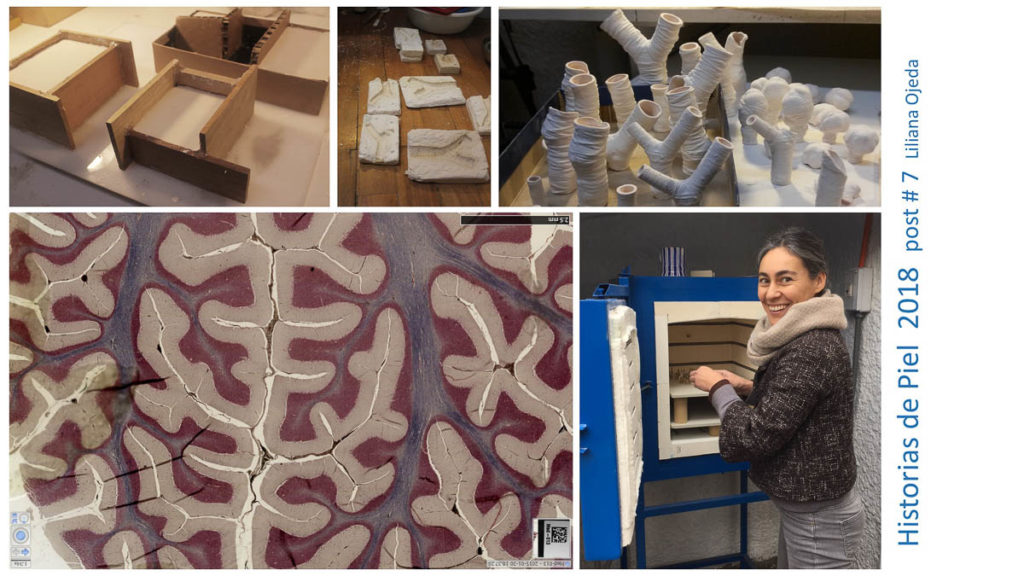- Liliana Ojeda, Bronco, 2018 porcelain, silver, cotton fabric, synthetic fiber; photo: Rosario Montero, makeup: María Eugenia Ojeda
The November laurel goes to Chilean jewellery artist, Liliana Ojeda. Her bold work uses a facility with materials to imagine internal forms within our body. The jewellery inverts the relationship between inside and outside. The body has been a strong theme in Chilean contemporary jewellery. Skin stories realises this interest in a wonderful suite of works, photographs and video. (English translation below)
Anatomías Invisibles
Se dice que las apariencias engañan, que no todo lo que brilla es oro. Yo estoy de acuerdo, desconfío de la mirada, y me aprovecho de su trampa para jugar a que una rama es un brazo, un pedazo de tela una piel, una bolsa amarrada una glándula.
El proyecto Historias de Piel se planteó como un desafío: negar lo visual. La estrategia fue fantasear con la idea de los órganos como receptores de sentimiento y subjetividad. Se hizo el ejercicio de imaginar la morfología de lo que no se ve ni se toca pero que acompaña nuestro cuerpo desde siempre. O, dicho de otro modo, darle forma y materia a lo invisible. ¿Cómo se sienten los ovarios? ¿Cómo se siente el intestino? ¿Cómo se siente el pulmón? En general se sabe que están ahí cuando nos dan problemas, pero ¿qué otras cosas nos entregan? ¿Puede haber emociones relacionadas a ellos?
Las respuestas no las tengo, pero me gustaría que, si las hay, se encarnaran en las obras. Con ellas propongo que nos revistamos con una piel nueva, la de nuestros órganos reinventados, anatomías flotantes, orgullosas de salir de su lugar y probar otro rol. Apoyada en el estudio de los sentidos, decidí poner énfasis en todo aquello que se puede percibir sin usar la vista. Elegí el tacto, complejo órgano de la percepción, el que envuelve nuestra anatomía y sin el cual no podríamos vivir y menos sentir.
Adicionalmente, me interesé en las ciencias de la imagen, aparatos que hacen visible lo invisible, y por medio de ellos me fue posible volver a revisar de cerca, muy cerca, los tejidos que conforman dichos órganos. Accediendo a otra dimensión que, para mí, también es táctil. Lo curioso es que al comparar los dibujos que había colgado hace un tiempo en la pared de mi taller, previo a la experiencia del microscopio, noté coincidencias sorprendentes; yo ya estaba dibujando todo eso que descubrí tras el lente de aumento…
Mi práctica pausada en el taller, se volvió un ritual que fue adquiriendo relevancia. Ese tiempo invertido en repetir gestos sobre los materiales, como envolver y apretar la arcilla, vendar ramas con hilos y géneros, producir cientos de conos, sería la obra en bruto o las piezas “madre”, que darían origen a todo lo que vendría después. Dejé que ese “no lenguaje” subjetivo y proveniente de mi ser primitivo se pusiera a hablar sin freno. Y duró hasta que decidí ponerle fin. Cerré el capítulo cuando pasé a la etapa fósil y congelé todas esas formas y huellas efímeras dentro de un bloque de yeso.
A partir de los moldes, construí todo el imaginario de esta serie Historias de Piel. Emprendí un viaje fascinante abrazada a mi capacidad de asombro. Y ahora quiero invitarte a humanizar el mundo reconociendo el lenguaje de estas anatomías invisibles.
Skin Stories_Historias de Piel from liliana ojeda on Vimeo.
Invisible Anatomies
It is said that appearances deceive, not everything that shines is gold. I agree, I distrust my eyes, and I take advantage of this to play a branch as an artery, a piece of cloth as skin, a tied bag as a gland.
This work belongs to the Skin Stories series, where I pose a challenge: to deny the visual. The strategy was to fantasize about the idea of organs as receptors of emotion and subjectivity. The exercise of imagining the morphology of what you do not see o do not touch, but that accompanies the body from the beginning. To give form and matter to the invisible. How do the ovaries feel? How does the intestine feel? How does the lung feel? We know that they exist when they give us problems, but what other things do they give us? Can there be emotions related to them?
I do not have the answers, but if there are any, I would like them to be incarnated in the works. With them, I propose that we cover ourselves with a new skin, reinvented organs, floating anatomies, proud to leave their place and try another role.
I became interested in the sciences of the image, using appliances that make the invisible visible (microscope), I was able to revise closely, the tissues that those organs are made of. Accessing another dimension that, for me, is also tactile.
My practice in the workshop became a ritual that was gaining relevance. Time inversion repeating gestures on materials, such as wrapping and squeezing clay, bandaging branches with threads and textile, producing hundreds of cones, would be the rough pieces I started with, which would give rise to everything that would come later. I let that “non-language” come from my primitive being to speak without restraint. And it lasted until I decided to end it. I closed the chapter when I went to the “fossil stage” by freezing objects on a plaster mould.
From those moulds, I built all the speculations of the Skin Stories series. I embarked on a fascinating journey embraced by my capacity of amazement. And now I want to invite you to humanise the world by recognising the language of these invisible anatomies.

“I live in a community in La Reina, Santiago, Chile. With other families, we share a common space full of fruit trees. I walk the park every morning with my dog, just before going to the workshop inside my house.” Liliana Ojeda
This project was able thanks to the financial support of Fondart 2018.








